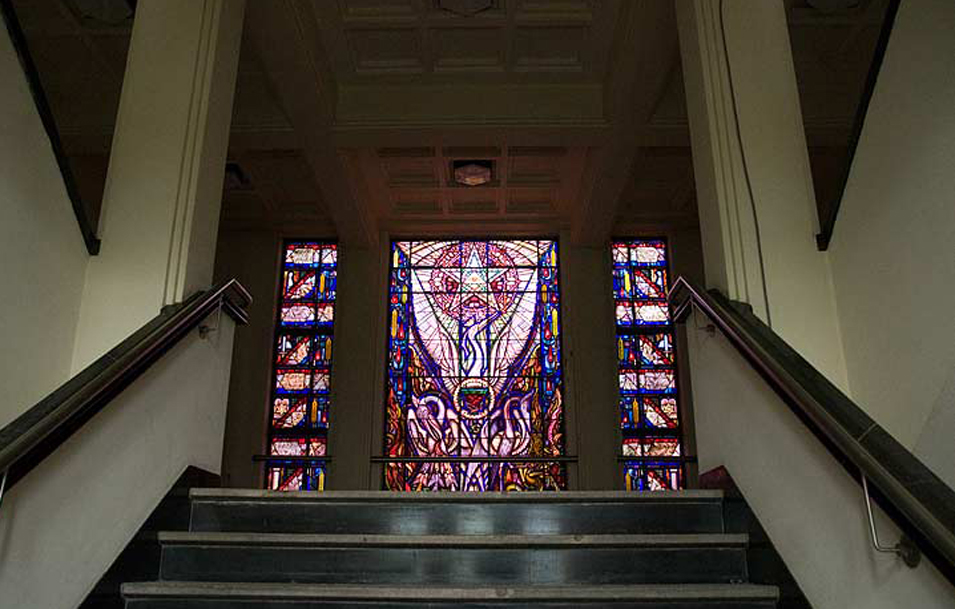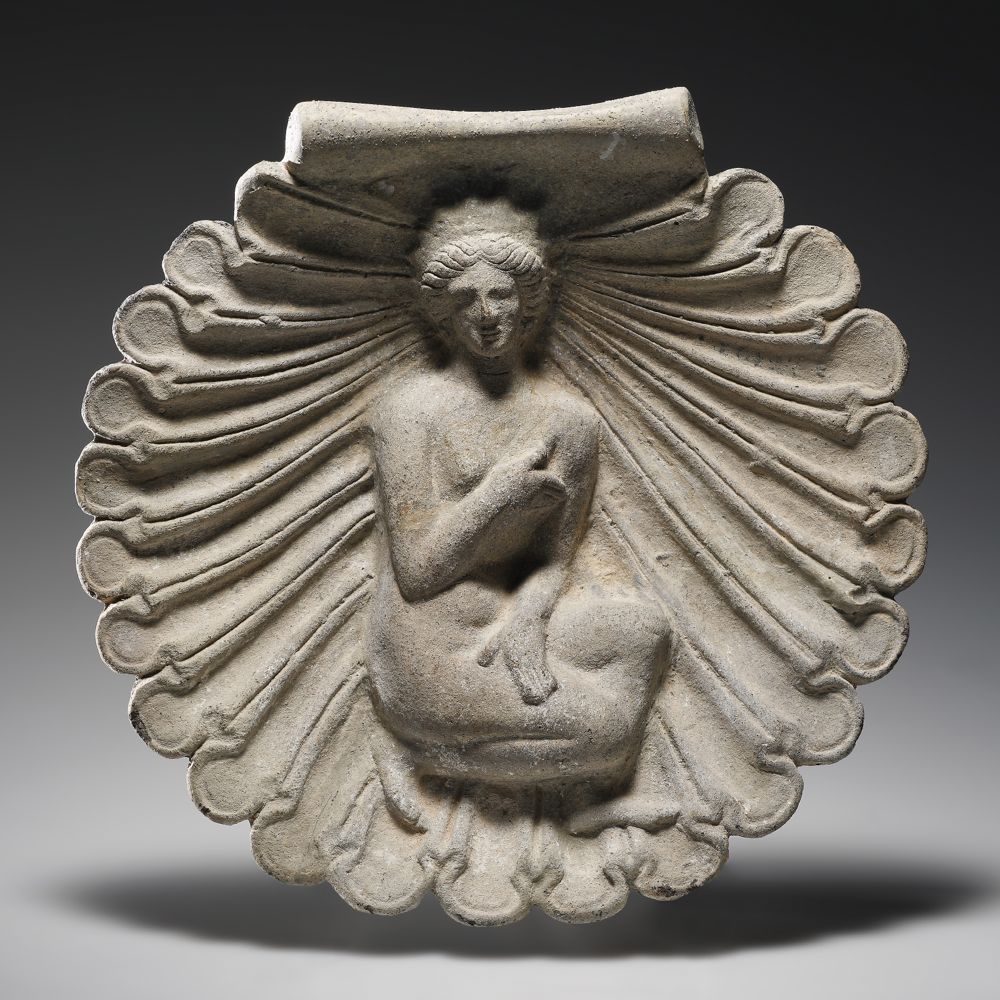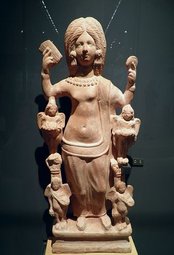It looks like you're using an Ad Blocker.
Please white-list or disable AboveTopSecret.com in your ad-blocking tool.
Thank you.
Some features of ATS will be disabled while you continue to use an ad-blocker.
share:
Imagine the scene, it is a dreary one, an old abandoned Shell Industrial building in Amsterdam, a pointless Left Wing occupy protest enters the
building...

With placards and pamphlets they wander through the desolate interior until their weary eyes fall upon a sight they never expected;

What is this they murmur among themselves much astonished, evidence of secret Devil Worship..!?!.. some prostrate themselves before the Phoenix Rising just in case.

And yet there is more, much more, they go on to discover more strange esoteric stained glass windows;

Seven multi-coloured maidens rising sensuously beneath the Morning Star, what can it all mean, they think to themselves, never having realized that Shell was an esoteric order...

Within a squared Field the Goddess of Shell gazes down upon them benignly, all wise and all knowing.

Finally realizing that they may have encountered culture they hurriedly flee the building never to return.


With placards and pamphlets they wander through the desolate interior until their weary eyes fall upon a sight they never expected;

What is this they murmur among themselves much astonished, evidence of secret Devil Worship..!?!.. some prostrate themselves before the Phoenix Rising just in case.

And yet there is more, much more, they go on to discover more strange esoteric stained glass windows;

Seven multi-coloured maidens rising sensuously beneath the Morning Star, what can it all mean, they think to themselves, never having realized that Shell was an esoteric order...

Within a squared Field the Goddess of Shell gazes down upon them benignly, all wise and all knowing.

Finally realizing that they may have encountered culture they hurriedly flee the building never to return.

Secret cults do perform their rituals in Warehouses and abandoned buildings, including those that purport to be for industrial use. Warehouses and
Industrial sites provide a great cover.
This is interesting. Did you take these pictures? If not, where did you get them? (Link?)
This is interesting. Did you take these pictures? If not, where did you get them? (Link?)
edit on 2018 by Skyfloating because: (no reason given)
a reply to: Skyfloating
I came across this on an 8ch site so i can't link there, but this is explained here;
The Laboratory

Though maybe not everything is explained there.
I came across this on an 8ch site so i can't link there, but this is explained here;
The Laboratory
the work of the petroleum company is depicted in the middle window. The main thing is distilling ; a fire burns under a flask with a few figures in 'turbid' colors at the bottom, the colors in the receiver above it are much brighter. At the top, the all-seeing eye is placed in a pentagram and signs of alchemy , including the philosopher's stone, and the symbols of the four elements on both sides of the flask . On the edge of the fire-plate a Latin inscription is placed, meaning "pray, read, read, reread, work and you shall find". In the side windows you can see the old and new signs for carbon, oil and hydrogen

Though maybe not everything is explained there.
edit on 13-7-2018 by Madrusa because: (no reason given)
The one picture is of a very old Shell gas pump back when one really did pump the gas by turning the crank wheel on the side to prime the pump.
Brought back memories
In the first pic , the "star" is rightside up . Not upside down . SO , not a Satan cult.
Looks like it is a shrine to Shell Oil.
Brought back memories
In the first pic , the "star" is rightside up . Not upside down . SO , not a Satan cult.
Looks like it is a shrine to Shell Oil.
The memorial windows of the Bataafsche Petroleum Maatschappij are three stained-glass windows in the Dutch city of Amsterdam , one of which can be regarded as a war memorial . [1] The windows were installed in the stairwell on the west side of the Groot Laboratorium, built in 1929 . [2]
Memorial windows
Anniversary
In 1939, on the occasion of the silver jubilee of the laboratory, a memorial was placed in the stairwell on the second floor. It was offered by the staff and in gratitude accepted by director Caviët.
The work of the petroleum company is depicted in the middle window. The main thing is distilling ; a fire burns under a flask with a few figures in 'turbid' colors at the bottom, the colors in the receiver above it are much brighter. At the top, the all-seeing eye is placed in a pentagram and signs of alchemy , including the philosopher's stone, and the symbols of the four elements on both sides of the flask . On the edge of the fire-plate a Latin inscription is placed, meaning "pray, read, read, reread, work and you shall find". In the side windows you can see the old and new signs for carbon, oil and hydrogen.[4] [8]
Memorial Window Second World War
After the Second World War , Nauta again created a memorial for the Great Laboratory , which was placed on the first floor. Three birds can be seen in the middle window: the central figure is a large, crowned phoenix (rebirth) rising from the flames, a pelican (sacrifice) with young on the bottom left and a crane (vigilance) on the bottom right, trampling a dragon with its legs . In a sort of banderole at the bottom of a fragment from the letter from Paul to the Galatians : "You were called to freedom".
On the two side windows are the names of seventeen employees of the Bataafsche Petroleum Maatschappij who died during the war, including the technologists dr.ir. Willem Coltof (1906-1944) and dr.ir. Hijman Limburg (1898-1944), chemist and resistance man Zeno Paul Polak (1888-1945) and lab technician Jacob Vos (1913-1943). Furthermore, symbols such as the Dutch flag , the stone tablets with a Star of David , a blood drop and a military helmet with sword are depicted. On 4 July 1947 the window was presented to the management by the staff, with Paul Huf declaiming some verses. [1] [9]
Caviët-window
The window on the third floor is dedicated to ir. Gerard Johan Louis Caviët (1887-1963). Caviët was in charge of the laboratory from 1920 until his retirement in late 1945 as director. It then grew into one of the largest industrial laboratories in the world. [10]
In the central window is a female figure, in her right hand she holds a board on which the field in Amsterdam can be seen in a bird's-eye view and the inscription "from 1920-1945 grew under GJL Caviët this Research laboratory". In her left hand she holds a tray on which an oil tanker and three derricks are shown. The BPM letters of the Bataafsche Petroleum Maatschappij stand around her head. On the side windows the crown of the Royal Oil and Shell scallop were placed on coats of arms .
nl.wikipedia.org...
a reply to: Gothmog
Yes it's the cultic associations of Shell Oil, relating to a Goddess that emerged on the shores of the Persian Gulf thousands of years ago, and the cult of worlds end at the end of the Santiago de Compostela pilgim trail, gas stations passing as shrines, the Pelican was her totemic bird, the star is Venus.



Yes it's the cultic associations of Shell Oil, relating to a Goddess that emerged on the shores of the Persian Gulf thousands of years ago, and the cult of worlds end at the end of the Santiago de Compostela pilgim trail, gas stations passing as shrines, the Pelican was her totemic bird, the star is Venus.



a reply to: GBP/JPY
Royal Dutch Shell does get accused of all sorts here, with this in mind it could be noteworthy that in the 1939 alchemy/distilling panel there is no all seeing eye within the Pentagram, yet in the 1947 panel there is.
a reply to: Trueman
I found Seven Sisters within, from the Pleiades.
Secret of the Seven Sisters
Seven Sisters Oil companies
Royal Dutch Shell does get accused of all sorts here, with this in mind it could be noteworthy that in the 1939 alchemy/distilling panel there is no all seeing eye within the Pentagram, yet in the 1947 panel there is.
a reply to: Trueman
I found Seven Sisters within, from the Pleiades.
Secret of the Seven Sisters
Throughout the region's modern history, since the discovery of oil, the Seven Sisters have sought to control the balance of power. They have supported monarchies in Iran and Saudi Arabia, opposed the creation of OPEC, profiting from the Iran-Iraq war, leading to the ultimate destruction of Saddam Hussein and Iraq. The Seven Sisters were always present, and almost always came out on top.
Preceding the 1973 oil crisis, the Seven Sisters controlled around 85 percent of the world's petroleum reserves
Seven Sisters Oil companies
edit on 13-7-2018 by Madrusa because: (no
reason given)
a reply to: Madrusa
when did this alledged " incident " ACTUALLY occurr ?
Imagine the scene, it is a dreary one, an old abandoned Shell Industrial building in Amsterdam, a pointless Left Wing occupy protest enters the building... ......................With placards and pamphlets they wander through the desolate interior until their weary eyes fall upon a sight they never expected; ......................Finally realizing that they may have encountered culture they hurriedly flee the building never to return.
when did this alledged " incident " ACTUALLY occurr ?
edit on 13-7-2018 by ignorant_ape because: (no reason given)
a reply to: ignorant_ape
2012
Occupy Amsterdam
2012
Two days later Occupy Shell protesters moved back to Exchange Square, claiming they were forced to flee the laboratory as it had been taken over by masses of people who had no interest in protesting and only came to take part in psyche-trance party. Also, another group of apparently mainly Eastern Europeans had stripped the building of its copper, and threatened protesters, who then called the police, who never showed up. The press linked these copper-gangsters and psyche-trance partiers to Occupy Amsterdam, despite the group’s own efforts to deny such associations.
Occupy Amsterdam
a reply to: MorpheusUSA
No English article only browser translate, the bulk of it was translated here

No English article only browser translate, the bulk of it was translated here

So apparently the Shell in Shell Oil logo is not a Shell. It is a rising sun.
This is the Cult of the Rising Sun.
Supposedly you can call Shell oil company or write them a letter, and ask them what their logo means.
They will tell you it is the Sun rising in between 2 mountain ranges. I've never done it myself but rumors are thats where it comes from.
This is the Cult of the Rising Sun.
Supposedly you can call Shell oil company or write them a letter, and ask them what their logo means.
They will tell you it is the Sun rising in between 2 mountain ranges. I've never done it myself but rumors are thats where it comes from.
edit on 13-7-2018 by booyakasha because: (no reason given)
7
[Chorus]
All seven and we'll watch them fall
They stand in the way of love
And we will smoke them all
With an intellect and a savior-faire
No one in the whole universe
Will ever compare
I am yours now and you are mine
And together we'll love through
All space and time, so don't cry
One day all seven will die
[Instrumental]
[Chorus]
All seven and we'll watch them fall
They stand in the way of love
And we will smoke them all
With an intellect and a savior-faire
No one in the whole universe
Will ever compare
I am yours now and you are mine
And together we'll love through
All space and time, so don't cry
One day all seven will die
[Verse 1]
And I saw an angel come down unto me
In her hand she holds the very key
Words of compassion, words of peace
And in the distance an army's marching feet (1 2 3 4, 1 2 3 4)
But behold, we will watch them fall
And we lay down on the sand of the sea
And before us animosity will stand and decree
That we speak not of love only blasphemy
And in the distance, 6 others will curse me
But that's alright (That's alright)
For I will watch them fall (1 2 3 4 5 6 7)
[Chorus]
All seven and we'll watch them fall
They stand in the way of love
And we will smoke them all
With an intellect and a savior-faire
No one in the whole universe
Will ever compare
I am yours now and you are mine
And together we'll love through
All space and time, so don't cry
One day all seven will die
[Verse 2]
And we will see a plague and a river of blood
And every evil soul will surely die in spite of
Their 7 tears, but do not fear
For in the distance, 12 souls from now
You and me will still be here - we will still be here
There will be a new city with streets of gold
The young so educated they never grow old
And a, there will be no death for with every breath
The voice of many colors sings a song
That's so bold
Sing it while we watch them fall
[Chorus]
All seven and we'll watch them fall
They stand in the way of love
And we will smoke them all
With an intellect and a savior-faire
No one in the whole universe
Will ever compare
I am yours now and you are mine
And together we'll love through
All space and time, so don't cry
One day all seven will die
[Outro]
(Just how old)
(Just how old)
(Just how old)
Song: 7
By: Prince
genius.com...
Geezus, Prince...what did you know or were in involved in??
[Chorus]
All seven and we'll watch them fall
They stand in the way of love
And we will smoke them all
With an intellect and a savior-faire
No one in the whole universe
Will ever compare
I am yours now and you are mine
And together we'll love through
All space and time, so don't cry
One day all seven will die
[Instrumental]
[Chorus]
All seven and we'll watch them fall
They stand in the way of love
And we will smoke them all
With an intellect and a savior-faire
No one in the whole universe
Will ever compare
I am yours now and you are mine
And together we'll love through
All space and time, so don't cry
One day all seven will die
[Verse 1]
And I saw an angel come down unto me
In her hand she holds the very key
Words of compassion, words of peace
And in the distance an army's marching feet (1 2 3 4, 1 2 3 4)
But behold, we will watch them fall
And we lay down on the sand of the sea
And before us animosity will stand and decree
That we speak not of love only blasphemy
And in the distance, 6 others will curse me
But that's alright (That's alright)
For I will watch them fall (1 2 3 4 5 6 7)
[Chorus]
All seven and we'll watch them fall
They stand in the way of love
And we will smoke them all
With an intellect and a savior-faire
No one in the whole universe
Will ever compare
I am yours now and you are mine
And together we'll love through
All space and time, so don't cry
One day all seven will die
[Verse 2]
And we will see a plague and a river of blood
And every evil soul will surely die in spite of
Their 7 tears, but do not fear
For in the distance, 12 souls from now
You and me will still be here - we will still be here
There will be a new city with streets of gold
The young so educated they never grow old
And a, there will be no death for with every breath
The voice of many colors sings a song
That's so bold
Sing it while we watch them fall
[Chorus]
All seven and we'll watch them fall
They stand in the way of love
And we will smoke them all
With an intellect and a savior-faire
No one in the whole universe
Will ever compare
I am yours now and you are mine
And together we'll love through
All space and time, so don't cry
One day all seven will die
[Outro]
(Just how old)
(Just how old)
(Just how old)
Song: 7
By: Prince
genius.com...
Geezus, Prince...what did you know or were in involved in??
edit on E31America/ChicagoFri, 13 Jul 2018 11:07:46 -05007amFridayth11am by
EternalShadow because: edit
originally posted by: Madrusa
I've been watching some Randall Carlson videos on Sacred Geometry recently, and he would have a field day with this kind of imagery. Geometric forms nested in a zodiac sign with heavy Cygnus symbolism right out of Gobekli Tepe? Right up his alley.
Sacred Geometry - Randall Carlson
a reply to: booyakasha
They refer to it as a Pecten, a scallop, were Pecten is Latin for Comb, a traditional accessory of Venus along with mirror.

a reply to: Blue Shift
Nobody ever gets the most obvious one though, the Pegasus square/Field constellation, think oil and think field, think the sum totality of organic elements.

a reply to: EternalShadow
Maybe the Seven Sisters should sue for bringing their reputation into disrepute?
a reply to: ignorant_ape
Artistic licence in skunk works...shut it down!!!
They refer to it as a Pecten, a scallop, were Pecten is Latin for Comb, a traditional accessory of Venus along with mirror.

a reply to: Blue Shift
Nobody ever gets the most obvious one though, the Pegasus square/Field constellation, think oil and think field, think the sum totality of organic elements.

a reply to: EternalShadow
Maybe the Seven Sisters should sue for bringing their reputation into disrepute?
a reply to: ignorant_ape
Artistic licence in skunk works...shut it down!!!
edit on 13-7-2018 by Madrusa because: (no reason given)
It's not satanic... Occultic, maybe. People should really be cognizant of the difference.
new topics
-
A Bunch of Maybe Drones Just Flew Across Hillsborough County
Aircraft Projects: 1 hours ago -
Who's coming with me?
General Conspiracies: 3 hours ago -
FBI Director CHRISTOPHER WRAY Will Resign Before President Trump Takes Office on 1.20.2025.
US Political Madness: 6 hours ago -
The NIH is still sending taxpayer money to Chinese Labs to Conduct cruel animal experiments
Mainstream News: 6 hours ago -
Angela Merkel is terrified of dogs
Politicians & People: 8 hours ago
top topics
-
The NIH is still sending taxpayer money to Chinese Labs to Conduct cruel animal experiments
Mainstream News: 6 hours ago, 11 flags -
FBI Director CHRISTOPHER WRAY Will Resign Before President Trump Takes Office on 1.20.2025.
US Political Madness: 6 hours ago, 8 flags -
Should be BANNED!
General Chit Chat: 16 hours ago, 6 flags -
Will all hell break out? Jersey drones - blue beam
Aliens and UFOs: 14 hours ago, 5 flags -
A Bunch of Maybe Drones Just Flew Across Hillsborough County
Aircraft Projects: 1 hours ago, 5 flags -
Who's coming with me?
General Conspiracies: 3 hours ago, 4 flags -
Angela Merkel is terrified of dogs
Politicians & People: 8 hours ago, 3 flags
active topics
-
FBI Director CHRISTOPHER WRAY Will Resign Before President Trump Takes Office on 1.20.2025.
US Political Madness • 13 • : WeMustCare -
ILLUMINATION – Reverse Perception Of Cyclic Probability – CEO ASSASSINATION
Secret Societies • 23 • : NoCorruptionAllowed -
Drones everywhere in New Jersey
Aliens and UFOs • 58 • : imitator -
UnitedHealthcare CEO Brian Thompson shot dead in Midtown Manhattan, masked gunman at large
Other Current Events • 170 • : interupt42 -
-@TH3WH17ERABB17- -Q- ---TIME TO SHOW THE WORLD--- -Part- --44--
Dissecting Disinformation • 3617 • : WeMustCare -
A Bunch of Maybe Drones Just Flew Across Hillsborough County
Aircraft Projects • 10 • : nugget1 -
And Here Come the Excuses!!
General Conspiracies • 152 • : cherokeetroy -
The Acronym Game .. Pt.4
General Chit Chat • 1006 • : JJproductions -
Who's coming with me?
General Conspiracies • 18 • : theatreboy -
The Final Experiment is Scheduled for December 2024. Will it Finally Answer the Question?
Science & Technology • 41 • : Arbitrageur
